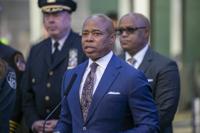SACRAMENTO, Calif. (AP) — In the rush to cut California's pollution and rid the state of fossil fuels, the most intriguing confrontation hasn't involved business leaders or the oil industry. Instead, it's simmering tensions between the state's robust environmental advocacy wing and California's progressive governor who considers himself one of their own.
The modern environmental movement has its roots in California, including the founding of the Sierra Club. Gavin Newsom, who rose from local politics in liberal San Francisco to become governor of the nation's most populous state, sees himself as a descendant of that progress, proudly carrying the movement's goals on the world stage.
Yet in the early days of Newsom's second term in office, some of his loudest criticism has come from inside the proverbial house. Newsom and environmental groups mostly agree on the big things, like rules banning the sale of new gas-powered cars and the goal of making California . It's how to get there that's causing friction.
Those last month during negotiations over California's . Newsom wanted major changes to the state's permitting and building process, saying it was taking far too long to build the kind of projects needed to update the state's aging water delivery system and boost clean energy to meet the state's .
But some Democrats in the Legislature and their environmental allies opposed the proposal, saying Newsom's plan — developed over the past year without their input — did not include enough protections for the state's fragile ecosystems, the threatened species that depend on them, and the low-income and tribal communities that live in them.
The disagreement was so sharp that Newsom threatened to veto the entire budget, but both sides came to a compromise. That compromise cleared the Legislature on Wednesday, and Newsom is expected to sign it into law next week. But the battle lines have been drawn.
Anthony York, Newsom's senior adviser for communications, said the environmental movement has mostly been about saying “no” to things to stop dirty projects that cause harmful pollution. Newsom, York said, wants to change that mindset.
“Being an environmentalist, it means being able to say yes to clean energy projects and clean water projects that will get us off of fossil fuels faster,” York said. “The fight you saw over infrastructure and streamlining is almost like an opening skirmish in some of the wars to come."
Some environmental leaders bristle at that characterization, including Barbara Barrigan-Parrilla, executive director of the environmental advocacy group Restore the Delta. She said Newsom's policies are aimed more at appealing to “small-town America for his presidential ambitions.”
"His plans for the Delta and rivers are strictly for the benefit of big industrial agriculture contributors,” she said.
Wednesday, tribal and environmental leaders rallied at the state Capitol to urge Newsom to change the state's water rights system and adopt rules to keep more water in the rivers to protect threatened species of fish.
Alan Duran attended the rally, saying he views 95% of what Newsom does as “very positive.” But he said he's been disappointed with Newsom's management of water, including a long-delayed update to state standards over how much water should be left in major rivers and streams to protect fish.
“The government has a responsibility to protect the environment and they aren't doing a good job of that,” said Duran, who was holding a sign that read “No trust until the fish are safe.”
In the Legislature, much of the friction has come from process. Newsom often shows up with complex proposals and demands lawmakers bypass their normal vetting process to pass them quickly — to the frustration of lawmakers who like to put their own stamp on policy.
“If we started working together earlier in the year we could have probably reduced a lot of the tension and friction,” Democratic Assemblymember Gregg Hart said. “Maybe that's a message to the governor’s team that we can get there if we just follow the regular process.”
Newsom says there‘s no time to wait. California has a target to cut its emissions 40% by 2030. To do that, it needs to cut emissions by 4% each year. Instead, the state has been cutting emissions by 1% each year in the past decade, according to the nonpartisan Legislative Analyst's Office. Likewise, with California accelerating its embrace of electric cars, state officials say the state needs to add an additional 40 gigawatts of new power over the next 10 years. One gigawatt is enough to power about 750,000 homes.
“The state needs to build. If you want to address extremes and you want to move to change the way we produce and consume energy, that means we have to be big in big things,” Newsom said during a news conference last week.
That vision can conflict with some of California's tribes. They say they have been largely left out of the state's complex system of determining who has the rights to take water from rivers and streams. Gary Mulcahy, government liaison for the Winnemem Wintu Tribe, said Newsom's plan to overhaul building and permitting codes will end up weakening environmental protections.
He accused Newsom of trying to fast-track “pet projects," including building a tunnel to change how the state transfers water from north to south.
“Of course we know they are going to hurt the environment," he said.
Newsom's plan specifically exempts the tunnel project. The Newsom administration says his plan does not weaken existing state environmental protections. Instead, it shortens the amount of time it takes to resolve environmental lawsuits filed to stop construction projects. Lauren Sanchez, Newsom's senior adviser for climate, noted Newsom has committed to spend more than $50 billion over the next few years on climate projects — an unprecedented amount.
It's one reason she said Democratic President Joe Biden came to California last month to talk about climate funding.
“We’re on the front lines of this crisis,” she said. “The state is dedicating more money to protecting the communities who are suffering from today’s climate impacts and making sure that we are able to fund our world leading agenda in cutting carbon pollution.”
___
This story has been updated to correct the spelling of Barbara Barrigan-Parilla's name










































